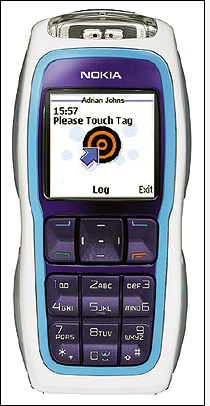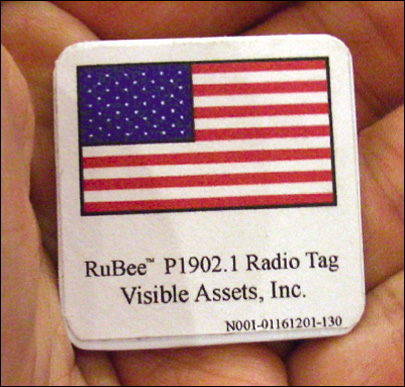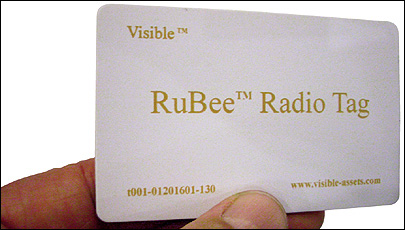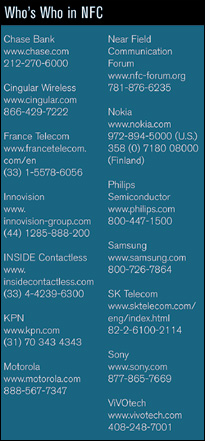Aug 01, 2006Mobile phones already have plenty of muscle: Many can snap digital photos, play music or video games and send and receive e-mail. Now a growing number of handset hardware manufacturers, software developers, banks, credit-card organizations and mobile telecommunications companies are joining forces to beef up mobile phones with a new technology—near-field communication (NFC), which will let users make payments, gather information and eventually exchange data with other mobile electronic devices.
The NFC Forum, an industry group founded by Nokia, Philips and Sony to promote the technology's adoption, is working to standardize NFC protocols. The technology is based on high-frequency (13.56-MHz) short-range RFID tags and interrogators that comply with ISO air interface standards 14443, 21481 and 18092. An NFC RFID tag is integrated into a cell phone's circuitry and can function as a passive tag or an interrogator, depending on the application.

When an NFC-enabled phone is presented to an RFID payment terminal, it acts as a passive tag, sending encrypted account information to the terminal the same way an RFID bank card or credit card is used to make a payment. The phone acts as an interrogator when it needs to collect data, such as reading a URL for a movie trailer or downloading a ring tone from an NFC-enabled smart poster or kiosk. Software, in the form of an application-programming interface (API), runs on the phone's operating system and sends the URL to the device's built-in Web browser, which downloads the appropriate data to the phone.
Nokia was the first company to add NFC capability to its mobile phones. Its 5140 and 5140i NFC phones, available in Asia, Europe and Latin America, are for commercial applications. The 3220 model is designed for consumers and is available worldwide. Samsung and Motorola have built prototype NFC models that are currently being tested in trials but are not yet commercially available.
The first application Nokia developed is called the Field Force Solution. It allows companies to keep abreast of the routines and special needs of field-deployed employees. It also provides a way for field employees to clock in and out of shifts and receive new work assignments.
But NFC technology is being most widely tested and deployed in consumer applications. Commuters in the German city of Hanau can use their Nokia NFC phones to purchase fares for the public transit system. NFC-based payment trials have also been completed or are planned in other European countries, including one using Nokia phones in Amsterdam, with credit-card organization JCB International and France Telecom, and one involving Samsung phones in France, with French credit-card organization Cofinoga and Dutch telecommunications firm KPN.
In the future, NFC will be used to link two or more devices so that they can send data back and forth—for example, two NFC phones could swap address book entries or music files. The NFC protocol does not allow for high bandwidth and fast data transmissions, so it's considered complementary to Bluetooth or Wi-Fi technology, which can transmit large amounts of data over RF quickly.
"I find NFC very compelling," says David Chamberlain, the principal analyst covering wireless technology for market research firm http://www.instat.com/ In-Stat>. "I really like the possibilities." But he says the technology companies need to adhere to the emerging NFC protocol standards in order for NFC to be successfully adopted, especially in the United States, where companies tend to compete by using different protocols, rather than rally around common ones.
Europe is currently the leader in NFC adoption, because of the availability of NFC phones. Nokia, Samsung and Motorola have added NFC capability only to those phones that use a standard called Global System for Mobile communication (GSM), which dominates the cell phone market in Europe. In the United States, many mobile telecoms only support phones that use the Code Division Multiple Access (CDMA) standards developed by Qualcomm. In Asia, both GSM and CDMA phones are widely used. Manufacturers are reportedly developing NFC-enabled CDMA phones.
The emergence of NFC standards is likely to entice more chipmakers to build NFC chipsets, and more phone manufacturers to add the technology to handsets. Today, Philips is the largest provider of the chipset that acts as the brain of the NFC module. But French firm INSIDE Contactless and British company Innovision are also developing NFC chipsets.
ABI Research predicts that more than 50 percent of all mobile phones worldwide will carry NFC technology by the year 2010.
Ever since the Institute of Electrical and Electronics Engineers announced that it was making the RuBee protocol a standard, many news stories have been proclaiming that the technology is better than radio frequency identification. One report even went so far as to say it could spell doom for RFID. There's only one problem: RuBee is RFID.
Visible Assets, the small firm in Miami that developed RuBee, named the protocol, tags and interrogators after the Rolling Stones' 1967 hit song "Ruby Tuesday." The RuBee tag functions at a low frequency (132 kHz), which gives it different capabilities compared with RFID tags that operate at high (13.56-MHz) and ultrahigh (856- to 960-MHz) frequencies.

At low frequency, data is carried via magnetic induction in the near field, which makes it more RF-friendly to products with metal or liquids. (With magnetic induction, the interrogator antenna generates an alternating magnetic field from a coil of wire. The tag also has a coil of wire that induces current from the magnetic field.)
But while RuBee tags can be read more reliably than any UHF tag placed on, say, a pallet of bottled water or canned foods, low frequency has slower data-transfer speeds than UHF. This means that only a handful of tags can be read per second. Plus, because the tag is battery-powered (a passive version is in development), it's not disposable and is considerably more expensive than passive UHF tags, making it a poor fit for the fast-moving supply chain.
Some end users might find RuBee an alternative to active (battery-powered) UHF tags used for tracking assets—if the assets contain liquids or metal and don't need to be read quickly. "RuBee is just one more tool in our toolbox to provide visibility for the enterprise," says Toby Rush, president of Rush Tracking Systems, a systems integrator that is working with Visible Assets on some RuBee deployments.
In early 2005, rumors were swirling inside the RFID industry that a handful of companies, including Re-factored Networks, i-Konect and N4, were creating open-source middleware, which they planned to offer for free to end users, charging only for installation, support and integration services.
"We thought RFID open-source software would really move the industry" by making the technology easier and cheaper for companies of all sizes to adopt, says Tom Rose, cofounder of i-Konect.

But Re-factored Networks folded, and i-Konect is too focused on its core RFID systems integration business to dedicate the resources required to bring its beta open-source RFID middleware, called Singularity, to completion. Rose says people in academia and the government, as well as commercial technology integrators, are interested in Singularity, but they want a finished product. Problem is, i-Konect can't finish it without a partner willing to share some of the development costs, time and risks.
Still, open-source middleware may yet do for the RFID industry what Linux, the free operating system, did for software developers. N4 convened a group of software developers, under the moniker RadioActive, to develop its open-source middleware. The company says it plans to release the software—called Fusion—very soon.
And Humberto Moran, founder of Open Source Innovation, believes open source holds tremendous promise for the RFID industry and end users. But first, he says, three things must happen: More members of the open-source software community need to learn about RFID; the RFID community needs to know about open-source software; and the commercial sector needs to invest in the software development.

